Being a board gamer these days can be tough. Rising costs, inadequate playtesting, the constant barrage of new crowdfunding projects, wrestling with schedules, face-to-face gaming restrictions, virtual tabletop growing pains, and shipping woes are all daunting topics.
As someone who has been on both sides, I can tell you that designers have it just as bad. Everything in the board gaming world, from wargames to dexterity games and everything in between, is under constant scrutiny from casual observers, players, and the tabletop communities. Cynical gamers think it’s all been done before and collectors are always on the hunt for the next big thing. With the influx of new designers and crowdfunding platforms available to put out any idea that someone can dream of, creating something that truly stands out both mechanically and aesthetically is getting harder and harder. The bar keeps getting higher, and we can either give up or rise to the challenge.
On the rare occasion when a game is a breakout hit, it isn’t always clear why. Sometimes, it can be attributed to increasingly high production values. Sometimes, it is related to clever gameplay. Sometimes, it’s even a well-developed theme. Many times, it can just be great marketing to the growing consumer base.
Let me introduce myself. My name is Jason Blake and I haven’t designed a board game before. So what led me to write this and you reading this? Let’s go back in time a bit.
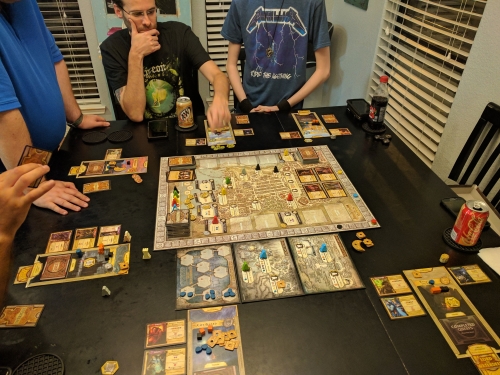 In 2015, my wife returned to college to obtain her Master’s degree. We shared a home office and it wasn’t easy for me to play video games in the same space where she was studying. I had to find something else to do with my free time (the horror). I grabbed my social circle of video game friends and told them to come over and play some of the board games I had been hoarding in my closet. This way, I could still hang out, play some games, and give my wife some peace and quiet for her studies. The 5-person video gaming group turned into a board gaming group almost overnight. Saturdays specifically became our go-to gaming night.
In 2015, my wife returned to college to obtain her Master’s degree. We shared a home office and it wasn’t easy for me to play video games in the same space where she was studying. I had to find something else to do with my free time (the horror). I grabbed my social circle of video game friends and told them to come over and play some of the board games I had been hoarding in my closet. This way, I could still hang out, play some games, and give my wife some peace and quiet for her studies. The 5-person video gaming group turned into a board gaming group almost overnight. Saturdays specifically became our go-to gaming night.
Early on, we played Eclipse, Kemet, Blood Rage, Dominant Species, Terraforming Mars, Tyrants of the Underdark, Dominion, 7 Wonders, Splendor, and Scythe, among several other titles. But as any gamer can relate, I thought we needed more games to try. 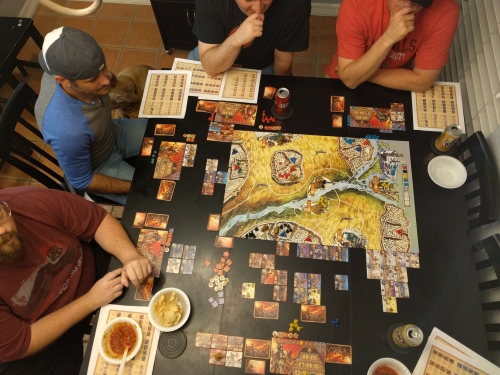 I became the host with the most! My current collection now spans over 600 games with half that many expansions… impressive by some standards but pales in comparison to others. Now we play just about anything and everything that I can get my hands on. Having a collection like that has allowed me to experience a lot of design ideas and interesting mechanics.
I became the host with the most! My current collection now spans over 600 games with half that many expansions… impressive by some standards but pales in comparison to others. Now we play just about anything and everything that I can get my hands on. Having a collection like that has allowed me to experience a lot of design ideas and interesting mechanics.
As my collection grew and my group played more and more games, I started seeing certain patterns and ideas recycle throughout designs. When I started looking into the design choices of games, I started asking a lot of mental questions about why certain design decisions were made. I became obsessed with figuring out why seemingly arbitrary rules were implemented when they typically made little difference to the surface-level understanding of how the game played. Once I started really looking at these designs, I started seeing why those rules existed. Not only were they there for balance, but also for edge cases and game-breaking concerns I had experienced countless times before — things like runaway leaders and catch-up mechanics. They could exist to prevent player elimination or to keep from stalling out a player’s progress. As I studied more and more, I started to realize how many designers and developers seemed to struggle with the domino effect of slight rule changes cascading across their entire game concept. It was all becoming so clear. So what did I do with all of that time, effort, and research? I had an arrogant thought that I could design a game too! Who needs experience or credentials? Heck, everyone is doing it now due to the open world of crowdfunding. So, why not me? Yea…
That was 2017.
I am writing this in 2022. You get the idea.
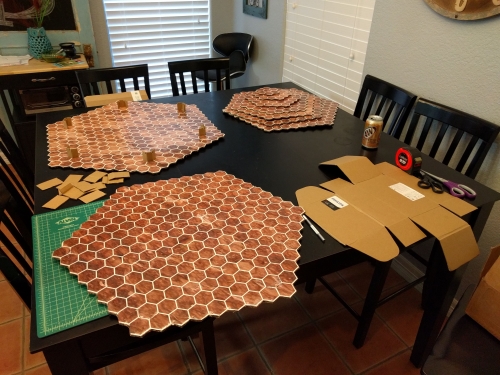 So, in January of 2017, I set off to make a game that I hadn’t seen before. I wanted to make a game that was a real showpiece. It needed table presence enough to warrant people stopping and looking at a convention or game store. I also thought that there was a new frontier for game boards to not be flat anymore. So, I initially set off to make a 3-D board game.
So, in January of 2017, I set off to make a game that I hadn’t seen before. I wanted to make a game that was a real showpiece. It needed table presence enough to warrant people stopping and looking at a convention or game store. I also thought that there was a new frontier for game boards to not be flat anymore. So, I initially set off to make a 3-D board game.
It was a strange concept of a king-of-the-hill battle game. I wanted it to have an extremely high level of player interaction and I wanted it to be competitive. I started writing a rulebook and once I thought I had a working idea, I made a concept board and used the miniatures from Kemet to try to play it by myself and see if it worked. 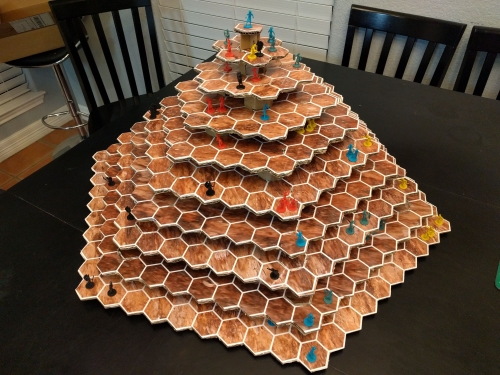
Spoiler Alert: It didn’t.
It was goofy, clunky, and the idea was weird. And yes, I used actual corrugated cardboard boxes to make this initial prototype. NEVER… AGAIN. It was horrible. I think I spent most of an entire Saturday cutting out the hexagonal-shaped edges with scissors. Of course, as soon as I shared this prototype pic with my current team, they pointed out the existence of the hex punch (seriously, guys?!).
Here’s an excerpt from my original rulebook.
“Board is now composed of hexes that are inscribed 1.58” and circumscribed 1.825”. This creates a circumscribed hex size for the entire bottom layer of exactly 30” with an inscribed dimension of 26.5” This yields a total of 1000 hexes. Level gaps are 1.5” and the game ends with a 13.5” tall gameboard. This should not be a problem for table height player sight as the board decreases in size and playtime as the height increases. Also, the levels can be seen through.”
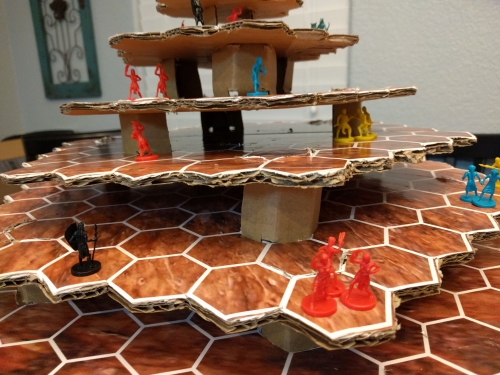 Yes, I know it sounds more like a word problem than a board game.
Yes, I know it sounds more like a word problem than a board game.
“New levels appear either by player cards or by secret passage exploration cards. Possible tremor events can also cause a new level to crash down.
When a level falls, the player who caused the event rolls a six-sided die. 1-2/no escape - 3-4/add 2 movement - 5-6/add 4 movement. Miners automatically tunnel upwards and never die from falling levels. All other units are crushed/trapped for the game duration.
In addition, the same player rolls another six-sided die and that determines the orientation of the asymmetric levels that fall. Each board will have a small number in the center that determines orientation placement.”
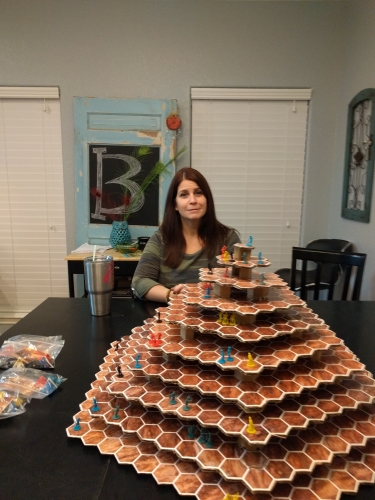 My wonderfully supportive wife has always been my biggest cheerleader but even she looks a bit skeptical here.
My wonderfully supportive wife has always been my biggest cheerleader but even she looks a bit skeptical here.
Even at this stage, I had some working titles that were interesting but maybe a bit too generic. Let’s take a look back at some of those:
SEISMIC, THE TOMB, JACOB’S LADDER, RISE, RUIN, PILLAR, TOWER, MONUMENT, ASCENSION (ASCENDENCY), LEVEL 10, PEAK, KING OF THE HILL, CLOSER TO GOD, PINNACLE OF GODLINESS, ESCAPE FROM HADES, VANTAGE POINT, COLLAPSE, THE CRUSH, CAVERN ESCAPE
What’s amazing here is that Seismic was my first choice from the earliest stage and somehow made it all this way, albeit spelled differently. I gave up on it until a good friend of mine convinced me it was the best name even though I argued there was already a BGG listing for a game called Seismic. That’s when I thought about spelling it differently and making it a bit more sci-fi feeling. Hence, “Cysmic” was born and was arguably the first feature of the project to become a static element that has since remained unchanged. Having said that, my initial design also included Soldiers, Miners, and Explorers… two of which have made it through five years of iterations to the final design. (Bye Bye Explorers!)
After falling on my face and becoming humbled by my own lack of experience and stupidity in thinking game design was easy, I really strapped in for the long haul of learning more about game design. I started hyper-focusing on the things I liked about other games and the things I didn’t like that I thought I could improve. For example, I was a huge fan of confrontational games with battles but I didn’t like player elimination.
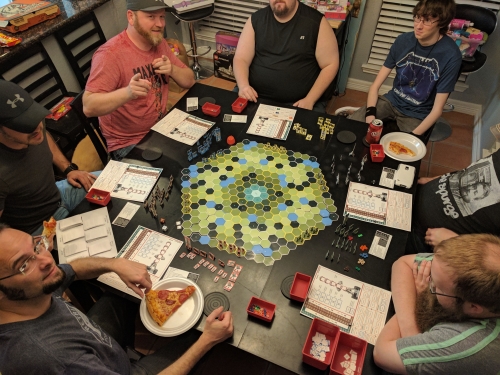 What are all of the problems I see with large dude-on-a-map games? I started a pretty long list of negatives to the point where I almost convinced myself that I DIDN’T like them. Dogpiling on one player… vulturing a player after they were weakened by another… player elimination or being virtually eliminated… only fighting your geographic neighbors and ignoring players across the table… arbitrary point scoring for fighting, or not… turtling and winning a war game… All of these things seem to plague most confrontational games to one degree or another. So, now I had my list of goals to meet and I also knew I still wanted the table presence. Let’s fast forward to the first major gameplay test. I made a new single-layer board and decided on a theme. It was modular and each outside edge would “fall away” throughout the game while the war was waging. Here’s an excerpt about the next design iteration after 6 months of starting the project.
What are all of the problems I see with large dude-on-a-map games? I started a pretty long list of negatives to the point where I almost convinced myself that I DIDN’T like them. Dogpiling on one player… vulturing a player after they were weakened by another… player elimination or being virtually eliminated… only fighting your geographic neighbors and ignoring players across the table… arbitrary point scoring for fighting, or not… turtling and winning a war game… All of these things seem to plague most confrontational games to one degree or another. So, now I had my list of goals to meet and I also knew I still wanted the table presence. Let’s fast forward to the first major gameplay test. I made a new single-layer board and decided on a theme. It was modular and each outside edge would “fall away” throughout the game while the war was waging. Here’s an excerpt about the next design iteration after 6 months of starting the project.
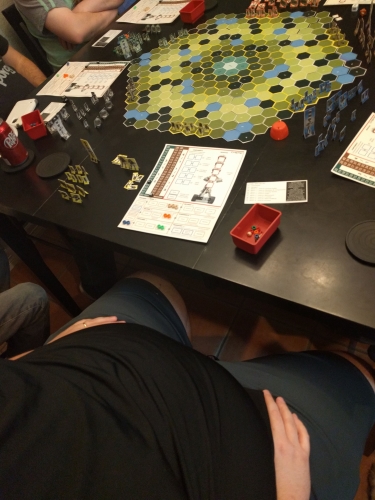
“JULY 24th, 2017
TITLE: Cysmic
NEW THEME: Rival factions search an uncharted wasteland as the last hope to escape off-world. They seek out the resources, artifacts, and technology necessary to build colony ships to leave their dying planet in a race against time. The searches will be perilous as entire landscapes of the planet change during tremors and seismic activity. Enemies build militaries in desperate attempts to steal resources from their rivals to get their own ships constructed. Other enemies are also causing seismic events by triggering traps created long ago by an ancient alien race as well as using alien artifacts to achieve their goal. Once the players obtain the necessary modules, they must bring them all to the alien launchpad to construct their ship and launch before the impending destruction of their homeworld.
GAME OVERVIEW: Desperate nations are trying to find the components necessary to leave the planet on a fabricated colony ship of their own. During the fight to leave the planet, the landscape is steadily changing from seismic activity resulting from the collapse of the planet’s structure. These landscape sections are also rigged to collapse by the ancient alien race that once called this planet home and can be triggered to change in certain circumstances. The required five Colony Ship Modules can be found through discoveries by way of searching (rare), engineered from component parts (semi-rare), or fabricated from raw materials through resource gathering (common). Once enemies have accumulated their own modules, those can be stolen through combat among the factions. This gives the player four methods to work towards achieving the goal of gathering everything needed to build the colony ship and leave the planet. A winning strategy would be to find a balance among all of those tactics to obtain the ship modules necessary to leave the planet.
You could focus on explorations to find the five necessary items. You could focus on engineering to fabricate the resources. You could focus on mining to acquire the resources needed to create the items. You could focus on building military strength to steal the items and keep others from working towards their goal.
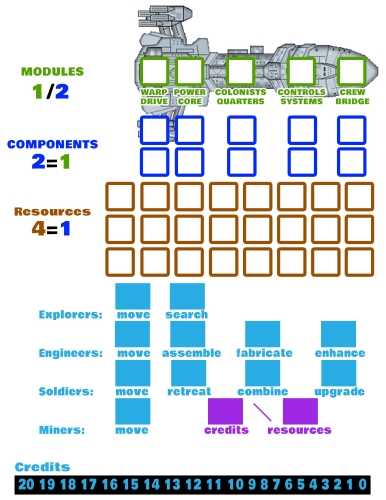 Upon obtaining all five of the unique modules, a player must then transport the assembled ship to one of six construction hangars to finish the shipbuilding process. This process requires one full round of work with at least one engineer. If there is no engineer on that hex for any part of that turn, then the player must start the process again the next round.
Upon obtaining all five of the unique modules, a player must then transport the assembled ship to one of six construction hangars to finish the shipbuilding process. This process requires one full round of work with at least one engineer. If there is no engineer on that hex for any part of that turn, then the player must start the process again the next round.
Once the shipbuilding process is complete, the ship and engineer can be moved into the center hex for launch if that hex is unpopulated. If more than one ship can be moved into the launch hex on a round, then the current turn order determines who can move into it first. If the ship and engineer can survive that last round to finish the launch sequence, then the player is considered to have a successful launch and wins the game.”
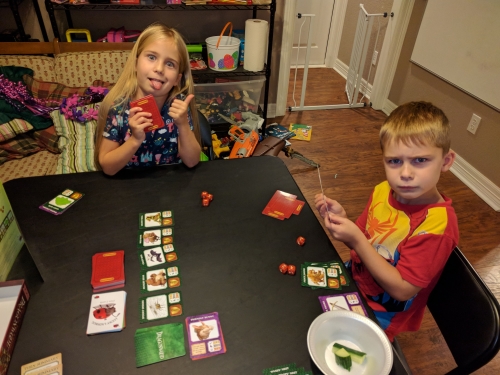 It’s not too far off from the current iteration but the actual gameplay and mechanics have changed significantly since then. However, this early in the development the theme was in place, the name was in place, and the game was actually playable with a really rough rulebook. I even have the first player board to share, which is a far cry from the current one for sure.
It’s not too far off from the current iteration but the actual gameplay and mechanics have changed significantly since then. However, this early in the development the theme was in place, the name was in place, and the game was actually playable with a really rough rulebook. I even have the first player board to share, which is a far cry from the current one for sure.
For now, I will leave you with an image of my twins trying out the game with me. This can help serve as a benchmark for time as we go through the series. Here, they were six years old. I was teaching them Dragonwood first and then trying to get them to play Cysmic shortly afterward. Needless to say, it didn’t completely work out.
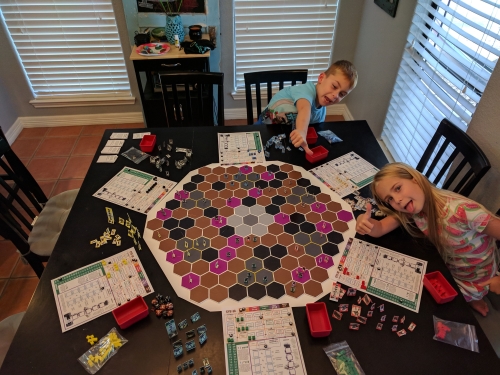
In my next entry, I will be exploring Cysmic’s early mechanics, why they did and didn’t work, and how they evolved over time. I also will cover the experience of bringing the game to my first convention and the earliest feedback I received from outside my own social circle. I hope you will follow along on this journey with me as I bring the game to Kickstarter. I hope that you will come to understand the passion, fascination, and tenacity behind Cysmic’s development. Until next time…
Jason Blake
Star Reach Games
CYSMIC
